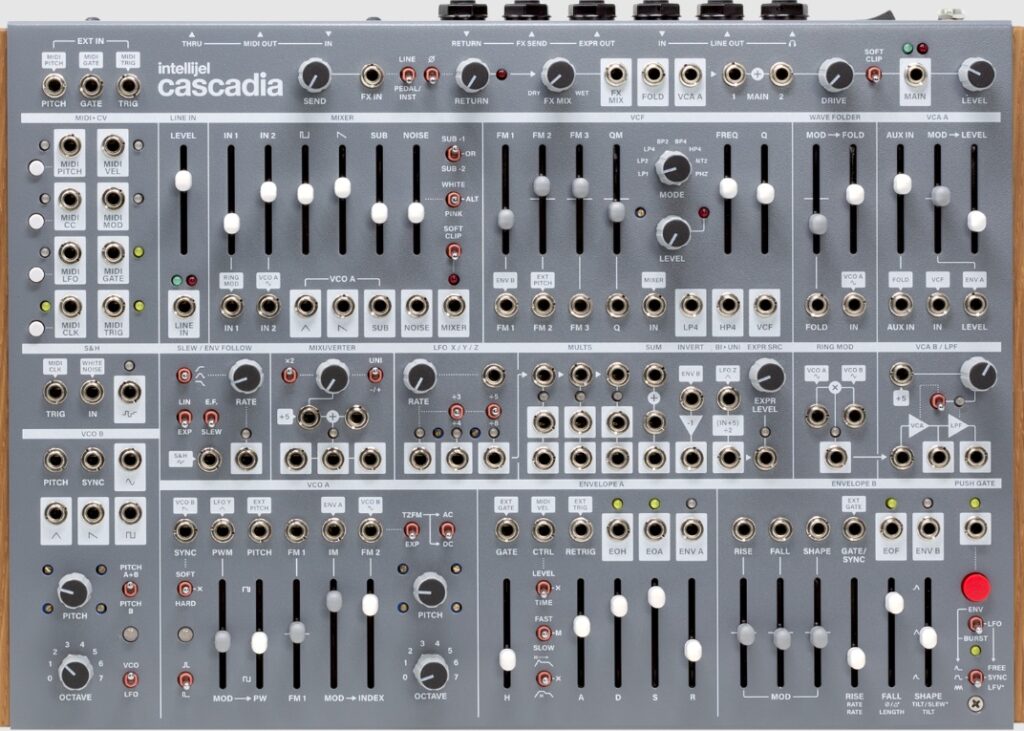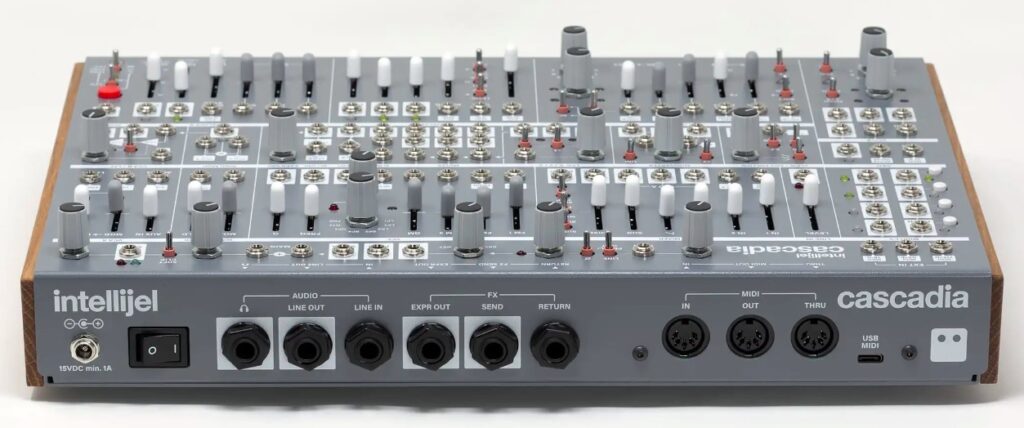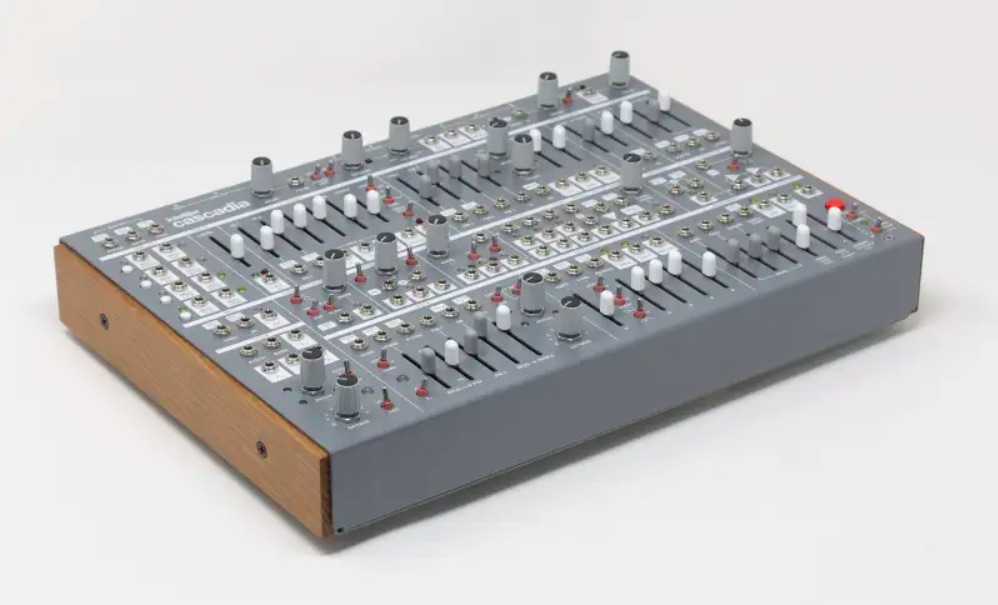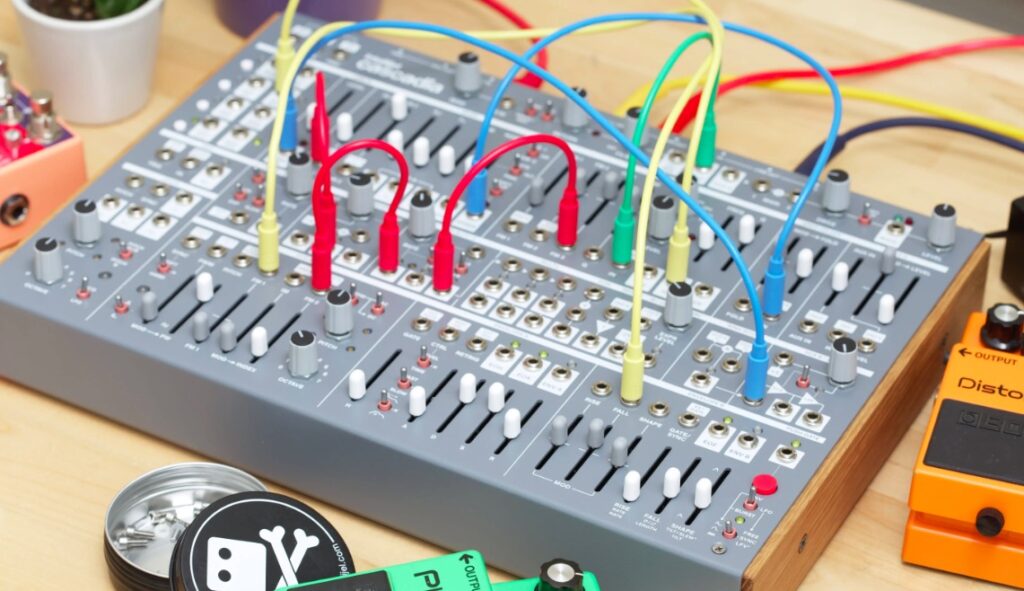One of Eurorack’s leading brands takes a step into the world of high-end semi-modular synthesis. Greg Scarth checks out this bold new move for Intellijel.

The Intellijel Cascadia is a serious instrument. That much is obvious just from a cursory glance at this fully analogue, semi-modular monosynth, but there’s a broader context too. The Cascadia is the first non-Eurorack offering from this Canadian brand, founded in 2009. Over those 14 years, Danjel van Tijn’s company has grown to be one of the leading names in modular synthesis. The Cascadia represents a small turning point in the Intellijel story, exploring the benefits of semi-modular synthesis and standalone desktop instruments. There’s certainly no suggestion that they’ll turn their back on Eurorack, but this is a big move and one which the brand has clearly taken seriously; no half measures here, this is very much a high-end synth.
The overall aesthetic of the Cascadia is in keeping with the brand’s modules, a classy grey-and-white colour scheme with neatly defined sections for each function and clearly labelled controls. Coming in at 348 x 246 x 66 mm, the synth is surprisingly compact considering just how much has been crammed inside. The semi-modular approach is highlighted by small arrows and labels above input sockets, both of which help to indicate the internal signal routing. The functionality of the Cascadia is backed up by extensive options for connecting controllers, sequencers, effects and external audio sources, with a built-in MIDI-to-CV converter neatly integrated, and the majority of input and output signals managed using controls laid out along a strip of space at the top of the front panel, effectively a slightly slicker take on the way many people lay out 1U modules at the top of Intellijel’s Eurorack Palette Cases.

In terms of synth architecture, the obvious starting point is down at the bottom of the front panel, just left of centre, where you’ll find the VCO A section, with VCO B just to its left. The two oscillators are designed to work in conjunction with each other, offering quite different designs but characterised by multiple waveform outputs, extensive modulation options, sync, thru-zero FM plus ring mod over in a separate section on the right. A mixer section vaguely reminiscent of the Roland SH-101 includes sub-oscillator signals and a noise source. The multi-mode VCF offers up to three simultaneous outputs plus extensive modulation options, with three FM sources plus resonance modulation. The most important modulation sources are the two envelope sections down on the bottom row, similarly contrasting in approach. Envelope A is the more simple of the two, an AHDSR design primarily used for amplitude envelopes. Envelope B is a more complex function generator which can be used for envelopes but also for LFOs and as a pulse burst generator.

The possibilities here are endless, but the internal signal normalling is handled exceptionally well in order to make the synth quick and easy to get started with. There’s a logic to everything which means anyone with a small amount of analogue synth or Eurorack experience should be able to get started even before consulting the Make A Sound chapter of the Cascadia’s excellent 111-page manual.
In terms of sound, the Cascadia is designed to be a mixture of East Coast and West Coast synthesis. It probably leans further to the East than West, but the presence of circuits like the wavefolder and VCA B’s low-pass filter lets you do a pretty good Buchla impression (combining the VCA and LPF effectively turns VCA B into a low-pass gate). You can do quite traditional subtractive stuff with ease, using those two lovely VCOs and the eight different flavours of filter on offer, but start dialling in some cross-modulation between the two oscillators, folding sine waves and using the ring modulator, you’re quickly into much more experimental territory. It might seem non-committal to describe the Cascadia as an all-rounder, but it’s a synth which likes being pushed into a lot of contrasting applications, just as happy doing retro Roland monosynth impressions as it is channelling Buchla or getting into weirdo ARP 2600 sounds.

The range of functions and features packed into a relatively compact instrument becomes more impressive the longer you spend with the Cascadia, as you come to realise that features like a slew limiter and envelope follower, ring modulator, sample-and-hold and wavefolder are dotted around in between the larger sections. Furthermore, almost every section packs more features than you might first expect, often accessed via toggle switches which change the functionality. Take, for example, the small LFO X/Y/Z section just left of the centre of the front panel: a single rate knob (plus CV input) controls the output of three triangle-wave LFOs, with the Y and Z signals being phase-shifted versions of LFO X. But LFOs Y and Z can also be divided to provide LFO signals running at a third, a quarter, a fifth or an eighth of LFO X’s rate. One tiny section with huge modulation options. Add the tempo-synced MIDI LFO signal from the MIDI to CV section, the option to run VCO B in LFO mode, plus the LFO mode for Envelope B, and you’re certainly not short of modulation signals.
As well as ticking all the big boxes gracefully, though, the Cascadia is littered with nice little touches like the soft clipping switches for the main mixer and output, a push button to trigger Envelope B manually and an FX send with switchable line/pedal/instrument levels. The FX send also includes an expression signal output, highlighting another area where the Cascadia shines, integrating other gear to become part of a bigger setup. It goes without saying that expanding the Cascadia’s potential is easy with Eurorack modules (the Metropolix sequencer would be the ideal starting point for us), but you can also hook up guitar stomp boxes, use expression pedals to modulate parameters, or process external audio signals through the Cascadia’s circuits.

At just over £2,000, the Cascadia is not cheap, but when compared to the realistic cost of putting together a similarly powerful Eurorack system, it’s clearly good value. What sets the Cascadia apart from that approach is the way it feels so much more cohesive than a collection of individual modules; from the normalled signal path to the ergonomic layout of functions, the Cascadia feels like a meticulously designed instrument. This synth doesn’t represent a rival approach to Intellijel’s firm Eurorack commitment, but complements it in an extremely pleasing way: on one hand, the fully open-ended approach of modular setups, on the other, the surprising depth and creative challenge of squeezing every last drop of potential from a defined set of circuits. Whichever approach you prefer, Intellijel have proven their mastery of creating inspiring instruments.
Greg Scarth
More info/buy